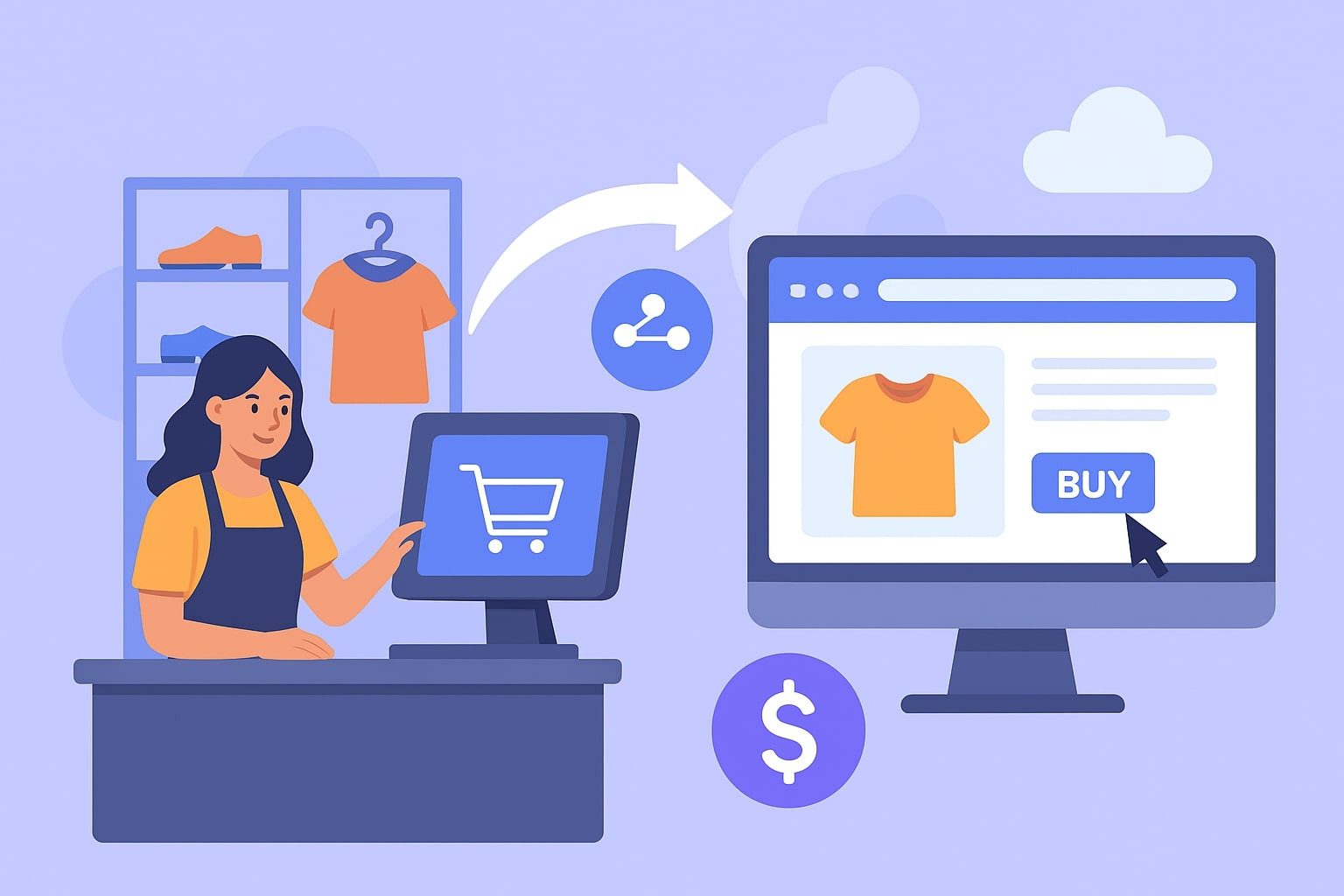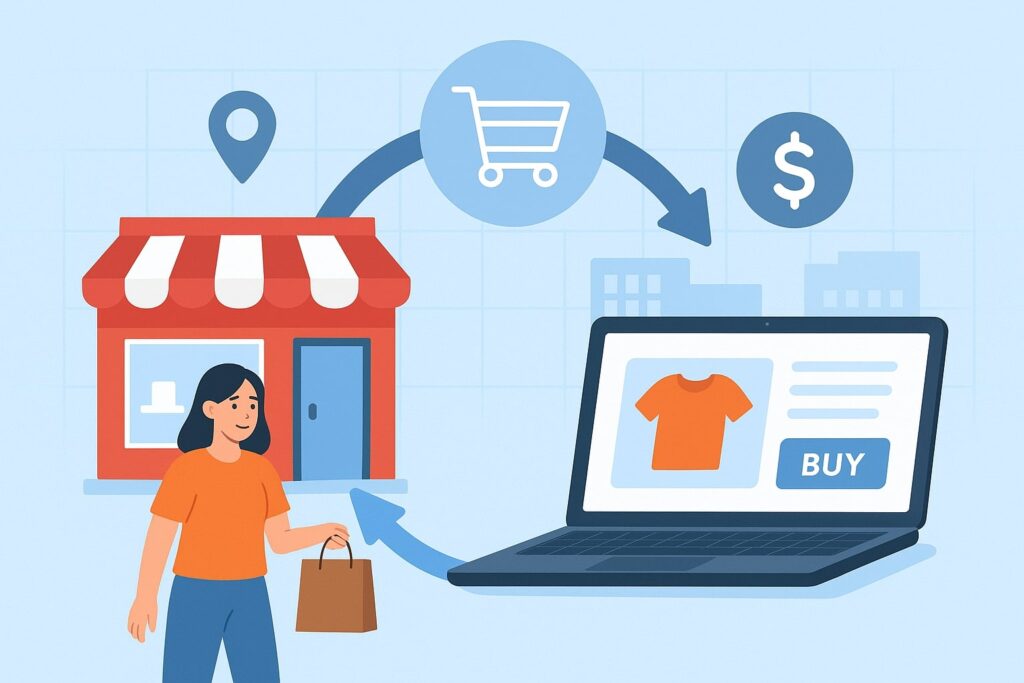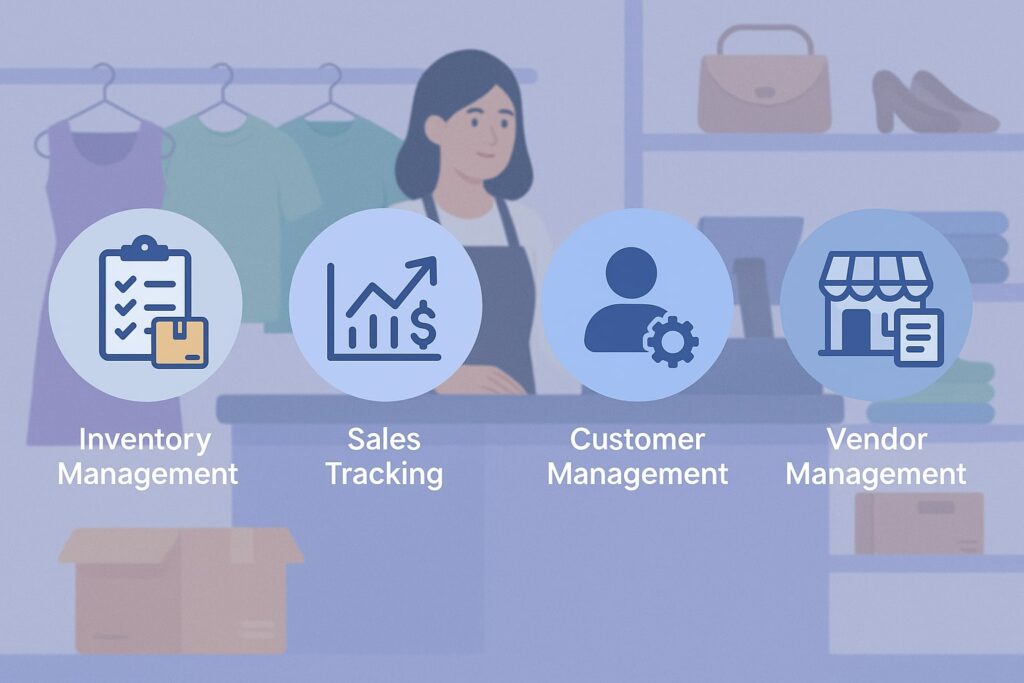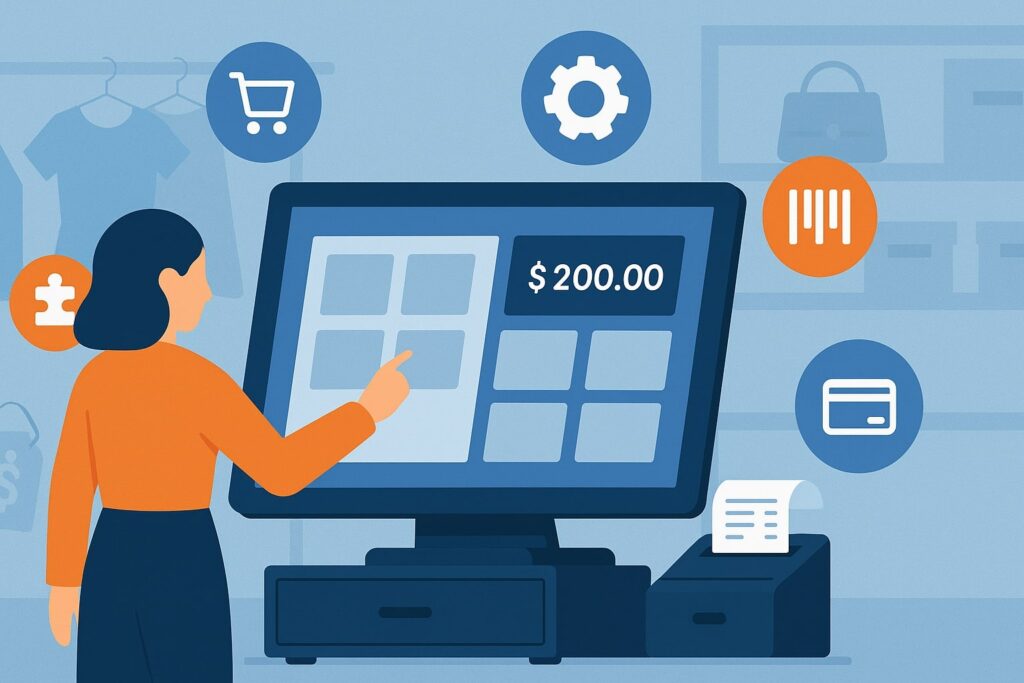
By consignmentpos September 13, 2025
Small consignment and resale shops are increasingly selling both in-store and online to reach more customers and boost revenue. Integrating your point-of-sale (POS) system with an eCommerce platform streamlines operations: one system manages inventory, sales, and consignor payouts across channels.
With the second-hand market booming (global resale eCommerce was ~$38.5B in 2023 and may exceed $64B by 2032), consignment store owners need tools that sync their brick-and-mortar and online sales.
In this guide, we explain consignment POS basics, key integration benefits, popular software options, and practical tips for seamless omnichannel selling.
What Is a Consignment POS System?
A consignment store sells goods on behalf of individual owners (consignors) and splits the proceeds per agreement. A consignment POS system is specially designed for this model.
Unlike a regular retail POS, it tracks each unique item and its consignor, applies custom commission splits, and automates consignor payouts. For example, if an item sells for $100 under a 60/40 split, a consignment POS automatically credits $60 to the consignor and $40 to the store.
Key differences from standard POS include:
- Consignor management: Each seller has an account. The POS links every item to a consignor and auto-calculates their share on sale.
- Unique inventory: Items are one-of-a-kind, so the system treats each as a separate SKU. Once sold (in-store or online), the POS removes it from inventory to prevent double-selling.
- Payout tracking: The software tracks exactly how much each consignor earns, and often supports printing checks, issuing store credit, or direct deposit (ACH) payments.
- Outright purchases: Many systems also handle outright buyouts or trade-ins alongside consigned items.
- Standard POS features: In addition to consignment needs, these systems provide normal checkout functions (barcode scanning, receipts, returns, promotions, etc.).
Traditional POS platforms (like generic retail or restaurant systems) lack built-in consignor accounting, so stores often start with spreadsheets or manual tracking. But as a consignment business grows, this becomes error-prone. Specialized consignment POS or add-on modules automate these tasks, saving time and improving accuracy.
Why Integrate In-Store and Online Sales?

Integrating your POS with online sales channels offers major advantages. First, it expands your market reach. You can sell to customers far beyond your local neighborhood and even operate 24/7.
The demand for second-hand goods is surging – environmental awareness and budget-conscious shoppers drive online resale platforms. In fact, the global online resale market is expected to grow from about $38.5 billion in 2023 to $64 billion by 2032.
Second, integration greatly boosts efficiency and accuracy. When your POS syncs in real time with an eCommerce site (Shopify, Square Online, WooCommerce, etc.), inventory is automatically updated.
A sale made online immediately deducts the item from in-store stock, and vice versa. This prevents double-selling an item to two different customers. It also ensures consignor accounts are always up to date; the system can automatically credit the correct consignor whenever an online order closes.
Other key benefits of POS–eCommerce integration include:
- Unified inventory management: One master list of products shows quantities for both channels. Employees don’t have to manually adjust stock levels or cross-check spreadsheets.
- Streamlined operations: Automating data transfer means no duplicate data entry. Orders, customer records, and inventory flow seamlessly between the POS and web store.
- Broader sales channels: Once inventory is online, you can easily connect to marketplaces and social platforms. For example, integrated systems let you list items on eBay, Facebook Marketplace, or Google Shopping without extra effort.
- Consistent customer experience: Customers see the same prices, discounts, and item availability whether shopping online or in-store. You can even offer in-store pickup for online orders or let website visitors check local inventory in real time.
- Unified reporting: Sales and inventory reports automatically combine online and offline data, giving you a full picture of performance across channels.
In short, multi-channel integration turns a consignment store into an omnichannel retailer, opening new revenue streams while reducing administrative work.
Key Features of Consignment POS Software

A robust consignment POS should handle both standard retail functions and consignment-specific tasks. Key features include:
- Consignor Management & Payouts: Automatically track and calculate each consignor’s share of every sale. Stores can set custom splits (e.g. 60/40, 70/30) per consignor or even per item.
The POS maintains running balances and supports scheduled payouts (via check, store credit or ACH). - Unique Inventory Tracking: Since items are often one-of-a-kind, the system must treat each as a separate SKU. You can assign unique tags or barcodes and record detailed descriptions or photos. Once an item sells on any channel, the POS prevents it from being sold again.
- Multiple Consignors & Agreements: Support for unlimited consignors, each with their own terms. Some software lets you store signed consignment agreements (with special splits or fees) in the system.
- Consignor Portal & Notifications: Modern solutions offer portals or apps where consignors log in to view the status of their items, earnings, and payment history.
Automated alerts can notify them when an item sells or when a payout is issued, improving transparency and trust. - Integrated Payout Processing: Beyond tracking, the POS simplifies paying sellers. It can print checks, credit store accounts, or send electronic payments by ACH or other methods. This saves time when handling dozens of consignor payments.
- Basic Retail Functions: Of course the system still does standard POS tasks: smooth checkout, barcode scanning, receipt printing or emailing, and returns. It also often includes customer management for buyers (email lists, loyalty programs, etc.).
- E-Commerce Integration: Perhaps most importantly today, the system should link to online sales channels.
Top consignment POS platforms either include a built-in web storefront or integrate with eCommerce platforms (Shopify, WooCommerce, BigCommerce, etc.). That way, you can list items online and have those sales automatically recorded in your POS. - Reporting & Analytics: Detailed reports on sales, inventory aging, consignor earnings, and more help you understand your business. Multi-channel reports (covering both in-store and online) are ideal for informed decisions.
By combining these features, a consignment POS streamlines the core business: tracking who owns what, what’s sold, and how to pay sellers – now extending that seamless tracking to every online order as well.
Popular Consignment POS Systems and Integrations

Many software options serve consignment and resale stores. They range from specialty systems built just for consignment to general retail POS with consignment add-ons. Here are some examples:
- Ricochet Consignment (by Shift6): A cloud-based POS designed for consignment shops. It provides full consignor accounts and splits, plus a mobile app for consignors (Ricochet GO).
Importantly, Ricochet offers two eCommerce paths: use Ricochet’s own webstore or connect to Shopify. Inventory syncs across channels and the app even alerts you to online sales. Pricing is a single plan ($159/mo) that includes all features and unlimited users. - SimpleConsign (Traxia): A cloud consignment POS with built-in inventory, POS, and consignor management. It handles unlimited items and split calculations. For online selling, SimpleConsign’s top-tier plan supports Shopify integration.
This syncs your inventory to an online store in real time, keeping consignor balances updated. (SimpleConsign also suggests you can connect to marketplaces like eBay or Facebook once you’re online.) - ConsignCloud: A modern, modular cloud POS for consignment. It has unlimited consignor accounts and advanced workflows (bulk actions, expiration rules, consignor portal, etc.).
ConsignCloud was built for multichannel selling: it offers official integrations with Shopify and Square. You can use Shopify to sell online while ConsignCloud handles backend tracking, or connect to Square POS/Online as the front end.
Inventory stays synced across systems. Pricing is tiered: the base plan starts at $119/mo (including 2 feature add-ons), scaling to $179 for all modules. - Liberty by Resaleworld: A longstanding (desktop and cloud) consignment solution for high-volume shops. Liberty includes everything from consignor accounting to buy-trade processing.
For online sales, Liberty supports multiple integration paths: Resaleworld’s own ShopRW webstore syncs directly with Liberty’s inventory, and there are add-ons for Shopify (syncing items and orders) and even eBay listing.
In practice, Liberty can act as a central hub so that an online order (from ShopRW, Shopify, or eBay) automatically updates inventory and consignor records in the POS. - Square for Retail + Consignor Connect (Rose): Square’s POS is popular with small retailers in the U.S. For consignment, you can use an add-on like Consignor Connect’s “Rose.”
Square itself comes with a free online store (Square Online) which ties into in-person sales. Rose adds consignment features (consignor portal, split tracking, etc.) and can connect that online store with consignment payouts.
For example, Rose’s Retail plan ($65/mo) explicitly includes “Integration with Square’s Online Store”. This hybrid approach lets you use Square’s easy POS interface and online shopping cart, with Rose handling the consignment-specific backend. - Shopify (with consignment apps): Although Shopify is not consignment-specific, it’s widely used for omnichannel retail. Shopify provides built-in POS (with in-person card readers) and real-time inventory sync between Shopify stores, social channels, and third-party marketplaces.
Its strength is managing multi-channel sales and advanced inventory tools. For consignment shops, you can extend Shopify via apps. For example, apps like Vendor Consignment (Visceral Apps) or Aravenda Consignment automate consignor payouts and inventory splits on Shopify.
This way, Shopify becomes a complete solution (online shop + in-store POS) with custom consignment workflows added. - Lightspeed Retail: A powerful cloud POS with native omnichannel features. Lightspeed supports selling online through either a built-in eCommerce module or by integrating with platforms like Shopify.
It also includes strong inventory management, multi-location tracking, loyalty programs, and integrations with accounting and marketing tools. Lightspeed can serve consignment stores that need advanced retail features and online selling in one system. - Other POS & Platforms: Some general retail POS systems (Vend, Clover, etc.) can be adapted for consignment with third-party plugins. Likewise, marketplaces like eBay or mobile platforms can be used, but they require careful syncing.
Importantly, once your POS is integrated with one system (like Shopify or Square), it’s easier to connect to others. For example, any items on a Shopify-based store could also be listed on Facebook, Instagram Shopping, or eBay to reach more buyers.
The table below compares a few popular solutions and their eCommerce integration options:
| POS System | E-Commerce Integration | Notes/Pricing |
|---|---|---|
| Ricochet | Built-in Ricochet webstore; Shopify | Flat $159/mo (no tiers) includes all features |
| SimpleConsign | Shopify (Professional plan only) | Cloud SaaS; eCommerce on top-tier plan |
| ConsignCloud | Shopify, Square Online, QuickBooks | Starts ~$119/mo (2 add-ons included), scalable |
| Liberty (Resaleworld) | ShopRW (Resaleworld webstore); Shopify; eBay | Cloud ~$160/mo or standalone license ($795+); powerful legacy system |
| Square + Rose | Square Online store | Square Free plan + Rose Lite ($30/mo) or Rose Retail ($65/mo) |
| Shopify POS | Native Shopify online store; consignment apps | $39–$399/mo plans; use apps for consignor payouts (ConsignR, etc.) |
| Lightspeed | Lightspeed eCommerce or Shopify | Plans from ~$89–$199/mo; includes loyalty, multi-store, accounting |
Each shop’s needs differ. Small stores might start with Square or Shopify plus an app, while large chains often use Liberty or Lightspeed. The key is choosing a system that automates consignor tracking and keeps inventory synced to wherever you sell.
Integrating Your POS with Online Sales
Setting up integration may sound technical, but modern POS systems and eCommerce platforms make it straightforward. Here are the general steps:
- Choose Your Platform(s): Decide on an eCommerce platform (Shopify, Square Online, WooCommerce, etc.) and a POS system.
You can use an all-in-one (e.g. Shopify POS + Shopify Store) or connect a dedicated consignment POS to a webstore. Ensure your POS either has built-in eCommerce or supports integration (via API or plugins). - Sync Products: Enter your consignor inventory into the POS with details and photos. Then use the integration to publish items online.
For Shopify or Square, this often means simply marking items as “for sale online.” For other setups, you may export/import or use connector apps. Automated syncing means updates (price changes, sales) happen instantly in both systems. - Configure Inventory Rules: Since consignment items are unique, set your POS to remove an item from all sales channels once sold.
Test this: if you simulate an online sale, the item should disappear from the in-store inventory. The POS will then automatically adjust the consignor’s balance. This ensures no customer can buy the same item twice. - Set Up Shipping & Pickup: Define shipping options in your online store (flat rate, carrier integration, local pickup, etc.) and link any order fulfillment to your POS. You may also configure notifications so that staff get alerts for online orders, just like walk-in sales.
- Train Staff: Teach employees how sales should be handled. For example, in-store, they use the POS as usual. For an online order that’s picked up in-store, scanning the item’s barcode in the POS should mark it complete.
If a customer returns an online purchase in-store, the return can be processed via the POS too. The goal is one consistent workflow. - Launch and Monitor: After thorough testing, enable the live integration. Keep an eye on orders and inventory for the first weeks to ensure everything syncs correctly.
Check that consignor accounts update in real time when online sales occur. Adjust any settings as needed.
The exact process will vary by system, but most providers (SimpleConsign, Ricochet, etc.) offer support and tutorials. The labor you put in upfront pays off: once set up, your POS and online store operate in harmony.
Best Practices for Seamless Sales
To make the most of your integrated setup, consider these tips:
- Use Unique Tags/Barcodes: Always tag every item with a unique barcode or ID. This prevents confusion when syncing. If an item is listed online, the code ensures the POS matches the exact product.
- Real-Time Sync: Enable real-time (or frequent) sync settings between systems. Delays can cause problems. As SimpleConsign notes, real-time syncing keeps inventory up to date across channels, eliminating manual work.
- Consistent Pricing & Policies: Keep prices and return policies consistent. If you run an online sale, make sure the POS reflects it (and vice versa). Tools like Shopify allow shared promotions and discount codes for online and in-store use.
- Good Photos and Descriptions: Online shoppers rely on images. Use clear photos and detailed descriptions for each consigned item. POS systems like Shopify POS let you attach images to items, which then appear on your webstore.
- Clear Consignor Communication: Ensure consignors know when their items sell. Portals and automated emails can help. A common practice is to send the consignor an email as soon as the POS records a sale (in-store or online). Many consignment POS apps handle this automatically.
- Offer BOPIS and Local Pickup: “Buy Online, Pick Up In Store” is very popular. It drives foot traffic. Make sure your POS knows an order is just a hold for a customer, not another item on the shelf. Ship-from-store (local delivery) is also an option if you have the staff.
- Leverage Multi-Channel Marketing: If you’re listed on Facebook Marketplace, Instagram Shop, or Google Shopping through your eCommerce platform, regularly update those.
These channels amplify your reach. As research notes, social media and influencers are pushing resale growth, so being active there can attract the younger “green” consumers who love thrift finds. - Monitor Inventory Closely: Periodically reconcile your stock. Even integrated systems can have discrepancies (e.g., returns or cancelled orders). Run reports in your POS that include online sales to spot any mismatches.
- Train for Returns: Have a clear process for returns and exchanges of online purchases. If someone buys an item online and returns it in person, the POS should accept it as a valid return and restock the item.
This is where real-time integration is crucial, so the returned item goes back to being available online if you relist it. - Analyze Omni-Channel Data: Take advantage of combined reporting. Look at sales trends across all channels: which items sell best online vs. in-store? Are certain product categories popular on marketplaces?
Use this insight to adjust inventory buying and marketing. A unified POS-eCommerce system gives you consolidated analytics.
By following these practices, your integrated system will not only run smoothly but also create a better shopping experience. Customers can seamlessly move between browsing online and visiting your store, while consignors and staff benefit from the efficiency.
Frequently Asked Questions (FAQ)
Q: What exactly is a consignment POS?
A: A consignment POS is a point-of-sale system built for consignment/resale shops. It includes features like consignor accounts, split-commission tracking, and unique item management.
This lets the store track each item’s owner and automatically calculate how much to pay them when it sells. In contrast, a regular retail POS treats all inventory as store-owned and doesn’t handle splits or consignor payouts.
Q: Can I sell online using my current POS?
A: Many modern POS systems offer eCommerce integrations. For example, Square POS can connect to a free Square Online store, and Shopify POS is built to sell online with Shopify’s eCommerce platform.
Dedicated consignment POS (Ricochet, SimpleConsign, etc.) either include a webstore or plug into platforms like Shopify. If your current POS doesn’t, you might need a connector app or to move to a system that supports online channels.
Q: How does inventory sync work when integrating?
A: With integration, your online store and POS share one inventory. If you sell an item online, the POS will mark that item as sold and update the stock immediately.
Many systems do this automatically via API. Some allow real-time syncing (instant) while others sync every few minutes. The goal is to prevent selling the same item twice.
Q: Do I need special training or staff for an integrated system?
A: Generally, no extra IT expertise is needed. These systems are made for retail owners. You will need to train staff on the new process (for example, handling online order pickups), but many consignment POS vendors offer onboarding support. The unified system is typically easier than juggling separate spreadsheets or manual methods.
Q: What if I already have items listed on eBay or Facebook?
A: You can often connect these as well. Some consignment POS solutions allow posting inventory to eBay or syncing to Facebook shops once your main store is online.
For example, Liberty POS can list on eBay and feed those sales back to the system. Alternatively, using a platform like Shopify, you can tap into built-in integrations for Facebook and Instagram Shopping.
Q: Are these integrations expensive?
A: Costs vary. There may be monthly fees for the POS and the eCommerce platform. For example, Ricochet is $159/month with no tiers, while Shopify plans start at $39/month plus the cost of consignment apps.
Square’s basic plan is free and its online store is free; you would just pay for a consignment add-on like Rose (starting around $30-$65/mo). Factor in transaction fees (POS vs. online) and any paid plugins. Overall, the efficiency and extra sales often outweigh the investment.
Q: Will my consignors be confused by online sales?
A: On the contrary, most consignors appreciate wider exposure. Good consignment POS systems send automatic notifications to consignors when their items sell, regardless of sales channel.
Your software should clearly report each sale’s origin (in-store vs online) and the resulting payout. Transparency keeps consignors happy, and they may even help market the online store to friends or on social media.
Q: Is it worth doing both in-store and online?
A: For most consignment shops, yes. Online sales open a much larger customer base and increase revenue opportunities, especially for niche or high-end items. Integrated systems ensure this is manageable.
As industry experts note, the resale market is booming and multi-channel operations are increasingly standard. By integrating your POS and going online, your consignment store can compete in the growing resale economy and keep a smooth local shop experience.
Q: How do I start with online integration?
A: Begin by choosing a platform. If you use Square, enable the Square Online store. If on Shopify POS, your online store is built in. If you have a specialized consignment POS, look into its supported integrations (Shopify, Woo, etc.) and sign up for that webstore or plugin.
Most providers offer free trials or demos – test the sync process before going live. Also, inventory preparation (photographs, descriptions) is key. After that, launch the integrated store and announce to your customers and consignors!
Conclusion
Integrating your consignment POS with online sales channels lets you “have the best of both worlds.” You keep the personalized, tactile experience of a local consignment shop while tapping into the vast online marketplace.
Modern consignment POS systems – whether dedicated solutions like Ricochet, SimpleConsign, ConsignCloud or hybrid setups like Shopify+ConsignR or Square+Rose – are designed to sync inventory and sales across every outlet.
This integration reduces errors and manual work. Every sale, no matter where it occurs, flows through one system that tracks inventory and consignor payments.
It also opens new revenue streams by letting people discover and buy your unique items online at any time. In today’s market, shoppers expect to find secondhand goods online, and consignment owners need tools to make that possible.
By choosing the right POS and eCommerce pairing, and following best practices, you can run a seamless omnichannel consignment business. Your in-store and online operations become two sides of the same platform, helping your business reach more customers, grow sustainably, and give consignors a better selling experience.